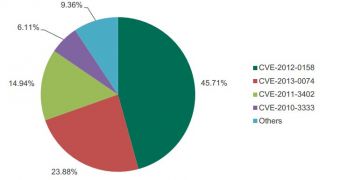A new report from Kaspersky on the vulnerabilities weakening Windows operating system revealed that 377 Microsoft products were plagued by 161 security glitches in the first half of 2014, based on information from open sources.
The information was collected by the security firm from publicly available details, as well as from MITRE Corporation, which is the source of CVE (Common Vulnerabilities and Exposures) content.
The security firm says that most of the problems, no less than 113 of them, affected the Internet Explorer web browser. There were also 19 vulnerabilities related to Microsoft's operating system, which means that glitches were found in various technologies, services and protocols used by Windows.
A total of 11 security glitches were discovered in the Office suite, including the web app that allows online access and editing of documents.
Compared to the first half of 2013, only the IE-related flaws are significantly higher, more than double in size.
The existence of vulnerabilities, however, may not necessarily mean that attackers can take advantage of them, because in some cases, an intruder may need to bypass several security mechanisms in order to reach the vulnerable component.
Exploiting the vulnerabilities, on the other hand, is a critical matter as it proves that security can be breached.
From November 2013 until June 2014, Kaspersky's systems recorded a total of four vulnerabilities that were most frequently exploited during cybercriminal activities.
CVE-2012-0158, a glitch in Microsoft Word that was first detected in October 2012, accounts for the largest part (45.71%). At the beginning of 2013, the security researchers observed that the flaw was used by the operators of Red October.
Affecting Silverlight, CVE-2013-0074 was the second most exploited glitch in the given time frame.
Coming in third place with 14.94% of the detections was CVE-2011-3402, which resides in the TrueType font processing and affects Windows versions from XP to 7.
Another Microsoft Word vulnerability, CVE-2011-3402, which was used in 6.11% of the intrusions detected by Kaspersky, was also employed in the cyber-espionage actions of the Red October operators.
None of the vulnerabilities exploited are new, the most recent one dating from March 2013, and all of them have been patched. However, despite fixes being available, not all users perform the necessary updates, giving cybercriminals the opportunity to break into their systems.
On the same note, the Kaspersky research found that exploits for a four-year-old error (CVE-2010-2568) in the way shortcuts are processed in Windows, which allows attackers to download the random dynamic library without the consent of the user, are still detected by the millions.
“In autumn 2010, Microsoft released a security update which patches this vulnerability. Despite this, Kaspersky Lab detection systems are still registering tens of millions of detections of CVE-2010-2568 exploits. Specifically, over the period of study more than 50 million detections on more than 19 million computers worldwide were recorded,” reads the report.
Kaspersky did not include this information in its statistics on purpose, because there is no way to accurately determine the cases in which the security product protected against a real attack or simply detected the tags generated by a worm.
Of course, the fact that many users are still working on Windows XP is actively contributing to the current statistics regarding CVE-2010-2568.

 14 DAY TRIAL //
14 DAY TRIAL //